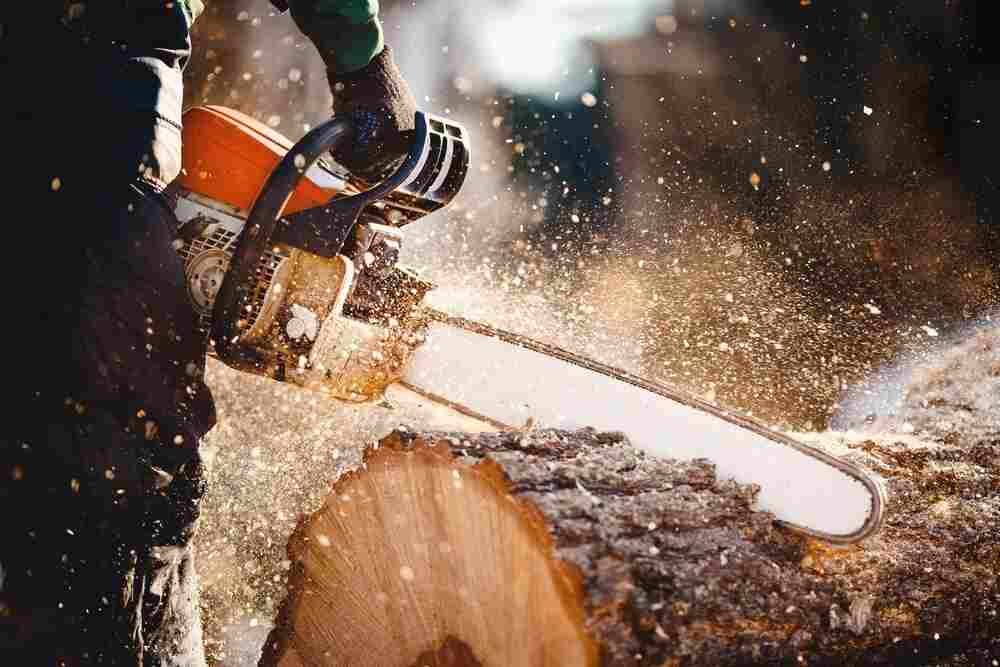Have you ever wondered how chainsaws should cut? They should always have smooth, clean cuts. If you have one, you should know this. However, if your chainsaw does something different, the chainsaw might be faulty.
Does your chainsaw cut on a curve? This means there is a problem. It is also not normal for the chainsaw to cut to one side even if you try your best to keep it straight. This is one of the signs that your chainsaw requires a chainsaw sharpener and proper maintenance. It also is a sign of a larger problem. Let us not hope for that at the end of the day.
Why Is Your Chainsaw Cutting Crooked?
When people find that their saws are not cutting straight thee first part they chek is the bar. It is quite logical to assume that a bent bar could be the reason for the problem. Afterall it guides the chain. When they find the bend in the bar, it is assumed that is the problem. Some people take the option of straightening the bar while others will do the next big thing—replace the entire bar. However, after changing the bar, the problem might still persist. That definitely means that the problem might not be in the bars after all. Most of the time, the main reason why the chainsaw will not cut straight is that the chain is faulty.

For example, unequal top plates cause the tooth to take uneven bites which force the chainsaw to move to a certain side, i.e. the side that takes up the most significant bite.
Size
One thing to check is the size of the top plate. They sit on the long pats of each of the tooth on the chain. All of the top plates should have the same size. In cases where the plates have different sizes. For example, one side is shorter than the other, look for the more extended parts and sharpen them to match the shorter sides—sharpen equally to avoid another issue. When the angles do not match, they will also cause curved cutting.
Uneven Sharpness
There is one thing that is reiterated when discussing sharpening chainsaws—it is evenness. All the teeth in the cutter have to be equally sharp, they have to be also filed at appropriate angles and have the same length—be precise when sharpening your battery chainsaw. When you make use of a grinder, it is easier than going hands on. Using the grinder encourages precision you will not be getting with the hands because details like the length, depth, and the angle can all be preset. because of the preset feature, it is easier to duplicate the process on each of the teeth. Filing is more complicated and less precise which is encouraged at all times when filing. It is easy to sharpen the left side of the cutter as a right-handed person but is tasking to file the right side of the cutter. Those who are left-handed experience the opposite effects in the filing. Teeth on the side that is easier to sharpen, remain significantly sharper than the side that is harder to sharpen, hence that problem might be because of natural human ineptitude.
If you use grinders, you are still not free from inaccuracies. Try to check for adjustment—get those damages out of the teeth. Check again for equality in the sizes of the top plate.
New Depths
If you wonder what the depth gauges are then you are in luck. They are small protrusions coming out of the saw’s teeth. This is a factor in determining if the saw can dig deep into the wood. The proper depth is a one-quarter inch. See the setting for the chain saw that you use and find the appropriate tool for it. To measure the depth gauge, set the tool atop the chain and allow the gauge to slide upwards after which they should be level with the slot top the part that is too tall have to be filed down.
Other Problem
If the problem is not maintenance or just sharpening, your chainsaw might have a bigger problem, which means that you might need professional help in getting the chainsaw fixed. As earlier said, a bent bar will not cut straight; this can be repaired or changed entirely. Dawg bolts which are not appropriately placed can also be the source of the problem if, for example, it sticks out. The chain will hit it and will make sure that that side is consistently dull.
What to Do When the Saw Does Not Cut Straight?
We have a message: when you notice that your cuts are not straight, take a look at the teeth on the chain before you spend unnecessary money, the chain is usually the problem because every other part of the chainsaw is built to be resistant. So, sharpen the chainsaw chain before delving into the next steps.
Saws that do cut straight can be dangerous and does not express professionalism. Do an excellent job with a properly maintained chainsaw all of the information is here for you and we hope we have been helpful.







